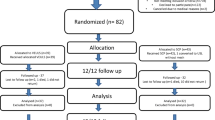Abstract
Background
The main indication for sacrospinous ligament suspension is to correct either total procidentia, a posthysterectomy vaginal vault prolapse with an associated weak cardinal uterosacral ligament complex, or a posthysterectomy enterocele. This study aimed to evaluate sexual function and anatomic outcome for patients after sacrospinous ligament suspension.
Methods
For this study, 52 patients who had undergone sacrospinous ligament fixation during the preceding 5 years were asked to complete the Female Sexual Function Index (FSFI) questionnaire. The patients were vaginally examined using the ICS POP score, and the results were compared with their preoperative status. For statistical analysis, GraphPad for Windows, version 4.0, was used.
Results
The 52 patients were examined during a follow-up period of 38 months. No major intraoperative complications were noted. Recurrence of symptomatic apical descent was noted in 6% of the patients and de novo prolapse in 13.5%. Only one patient was symptomatic. Three patients experienced de novo dyspareunia, which resolved in two cases after stitch removal. Sexual function was good, rating higher than three points for each of the domains including satisfaction, lubrication, desire, orgasm, and pain.
Conclusion
Sacrospinous ligament fixation still is a valuable option for the treatment of vaginal vault prolapse. Sexual function is satisfactory, with few cases of de novo dyspareunia.


Similar content being viewed by others
References
Amreich Aetiologie und Operation des Scheidenstumpfprolpases (1951) Wien Klin Wochenschr 63:74–77
Richter K (1968) Die chirurgische Anatomie der Vaginaefixation sacrospinalis: Ein Beitrag zur operativen Behandlung des Scheidenblindsackprolapses. Geburth Frauenheilk 28:321–327
Carey MP, Slack MC (1994) Transvaginal sacrospinous colpopexy for vault and marked uterovaginal prolapse. Br J Obstet Gynecol 101:536–540
Morley GW, DeLancey JO (1988) Sacrospinous ligament fixation for eversion of the vagina. Am J Obstet Gynecol 158:872–881
Cruikshank SH, Cox DW (1990) Sacrospinous ligament fixation at the time of transvaginal hysterectomy. Am J Obstet Gynecol 162:1611–1619
Cruikshank SH (1991) Sacrospinous fixation: should this be performed at the time of vaginal hysterectomy? Am J Obstet Gynecol 164:1072–1076
Hefni M, El-Thouky T, Bhaumik J, Katsimanis E (2003) Sacrospinous cervicocolpopexy with uterine conservation for uterovaginal prolapse in elderly women: an evolving concept. Am J Obstet Gynecol 188:645–650
Kovac RC, Cruikshank SH (1993) Successful pregnancies and vaginal deliveries after sacrospinous uterosacral fixation in five of nineteen patients. Am J Obstet Gynecol 168:1778–1790
Kettel ML, Herbertson RM (1989) An anatomic evaluation of the sacrospinous ligament colpopexy. Surg Gynecol Obstet 168:318–322
Peters WA, Christenson ML (1995) Fixation of the vaginal apex of the coccygeal fascia during repair of vaginal vault eversion with enterocele. Am J Obstet Gynecol 172:1894–1902
Paraiso MF, Ballard LA, Wallace MD (1996) Pelvic support defects and visceral and sexual function in women treated with sacrospinous ligament suspension and pelvic reconstruction. Am J Obstet Gynecol 175:1423–1431
Holley RJ, Varner RE, Gleason BP (1995) Recurrent pelvic support defects after sacrospinous ligament fixation for vaginal vault prolapse. J Am Coll Surg 180:444–448
Suckling J, Lethaby A, Kennedy R (2006) Local oestrogen for vaginal atrophy in postmenopausal women (review). Cochrane Database Syst Rev 18(4):CD001500
Sze EH, Karram MM (1997) Transvaginal repair of vault prolapse: a review. Obstet Gynecol 89:466–475
Barksdale PA, Gasser RF, Gauthier CM, Elkins TE, Wall LL (1997) Intraligamentous nerves as a potential source of pain after sacrospinous ligament fixation of the vaginal apex. Int J Pelvic floor Dysfunct 8:121–125
Richter K, Albrich W (1981) Long-term results following fixation of the vagina on the sacrospinous ligament by the vaginal route. Am J Obstet Gynecol 141:811–816
Holley RL, Varner RE, Gleason BP, Apffel LA, Scott S (1996) Sexual function after sacrospinous ligament fixation for vaginal vault prolapse. J Reprod Med 41:355–358
Estrade JP, Agostini A, Roger V, Dallay D, Blanc B, Cravello L (2004) Sacrospinous colpopexy complications. Gynecol Obstet Fertil 32:850–854
Farrell SA, Scotti TA, Ostergard D (1991) Massive evisceration: a complication following sacrospinous vaginal vault fixation. Obstet Gynecol 78:560–562
Rosen R, Brown C, Heiman J, Leiblum S, Meston C, Shabsigh R, Ferguson D, D’Agostino R Jr (2000) The Female Sexual Function Index (FSFI): a multidimensional self-report instrument for the assessment of female sexual function. J Sex Marital Ther 26:191–208
Robinson JG, Molzahn AE (2007) Sexuality and quality of life. J Gerontol Nurs 33:19–27
Hines TM (2001) The G-Spot: a modern gynaecologic myth. Am J Obstet Gynecol 185:359–362
Smith LJ, Mulhall JP, Deveci S, Monaghan N, Reid MC (2007) Sex after seventy: a pilot study of sexual function in older persons. J Sex Med 4:1247–1253
Bancroft JHJ (2007) Sex and aging. New Engl J Med 357:820–822
Scherlitz L, Dwyer P, Rosamilia A, Murray C, Thomas E, Taylor N, Hiscock R, Lim Y, Achtari C, De Souza A (2007) A prospective randomised controlled study comparing vaginal prolapse repair with and without tension free vaginal tape (TVT) in women with severe pelvic organ prolapse and occult stress incontinence. ICS annual meeting Rotterdam, Abstract 114
David-Montefiore E, Barranger E, Dubernard G, Nizard V, Antoine JM, Darai E (2007) Functional results and quality of life after bilateral sacrospinous ligament fixation for genital prolapse. Eur J Obstet Gynecol Reprod Biol 132:209–211
Handa VL, Zyczinski HM, Brubaker L, Nygaard I, Janz NK, Richter HE, Brown MB, Weber AM (2007) Pelvic disorders network: sexual function before and after sacrocolpopexy for pelvic organ prolapse. Am J Obstet Gynecol 197:629.e1-6
Author information
Authors and Affiliations
Corresponding author
Rights and permissions
About this article
Cite this article
Baumann, M., Salvisberg, C., Mueller, M. et al. Sexual function after sacrospinous fixation for vaginal vault prolapse: bad or mad?. Surg Endosc 23, 1013–1017 (2009). https://doi.org/10.1007/s00464-008-0108-5
Received:
Revised:
Accepted:
Published:
Issue Date:
DOI: https://doi.org/10.1007/s00464-008-0108-5




